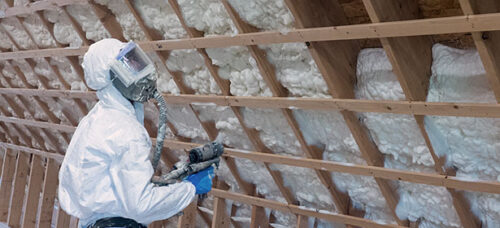
Spray foam insulation in the roof has gained popularity in recent years due to its ability to provide excellent thermal insulation and air sealing properties. However, there are a few considerations and potential issues associated with spray foam insulation in the UK that should be taken into account.
Firstly, it’s important to note that spray foam insulation is a highly effective insulating material when installed correctly. It can significantly reduce heat loss and improve energy efficiency in buildings. However, improper installation can lead to problems. In the case of roof insulation, if the spray foam is not applied evenly or if there are gaps or voids in the application, it may not perform optimally. This can result in thermal bridging, where heat escapes through the uninsulated areas, reducing the overall effectiveness of the insulation.
Another potential issue with spray foam insulation is its potential for moisture-related problems. In the UK, where the climate is often damp, moisture control is crucial to prevent condensation and mould growth. If the roof structure has existing moisture issues, such as leaks or inadequate ventilation, spray foam insulation may exacerbate these problems. Moisture can become trapped within the insulation, leading to rot, decay, and mould growth, which can compromise the integrity of the roof and pose health risks to occupants. This can lead to difficulties if you come to sell the property or require finance or equity release.
The Government released a response to questions being raised in Pariliament in April 2023 – read here.
Additionally, the application of spray foam insulation requires professional expertise. It involves the use of chemicals and specialized equipment, and improper installation can result in health and safety hazards. It is crucial to engage a reputable and experienced contractor who understands the specific requirements and best practices for spray foam insulation in the UK. This ensures that the insulation is applied correctly and that potential risks are minimized.
Furthermore, the environmental impact of spray foam insulation should be considered. Some types of spray foam contain blowing agents with high global warming potential (GWP), which can contribute to climate change. However, there are more environmentally friendly options available, such as water-blown or low-GWP formulations. It is essential to choose a product that aligns with sustainability goals and meets regulatory standards.
Lastly, building regulations and standards in the UK should be followed when installing spray foam insulation. In England, for example, building regulations require that insulation materials meet certain fire safety standards. It is crucial to ensure that the spray foam insulation being used complies with these regulations to maintain the safety of the building and its occupants.
In conclusion, spray foam insulation in the roof can provide excellent thermal insulation and air sealing benefits when installed correctly. However, it is essential to consider potential issues such as improper installation, moisture-related problems, the need for professional expertise, environmental impact, and compliance with building regulations. Engaging a qualified contractor and carefully considering the specific requirements and challenges in the UK can help mitigate these concerns and ensure the successful implementation of spray foam insulation in roofs.